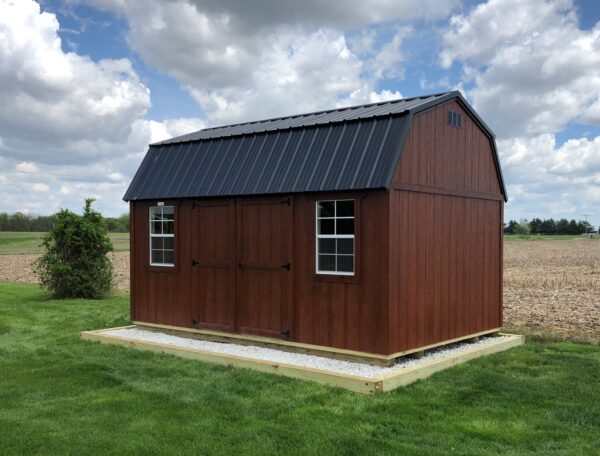When it comes to shed foundations, one size doesn’t fit all. Just as there are many different types of sheds, there are also many different types of foundations.
Selecting the best foundation for your particular needs is an important decision in shed design. You want your shed to last, and the wrong foundation type can reduce the lifespan of a shed by many years. It can also eliminate a number of problems down-the-road, like doors not closing properly, windows not opening properly, and a leaking roof.
When planning a shed, one of the questions we get asked is, “Do I need a foundation?” We believe the answer is “Yes.” Sheds lacking a foundation can quickly become unlevel and the exposed flooring can absorb plenty of moisture, which will lead to mold and mildew issues. This can quickly damage the structural integrity of the shed. A well-built shed that will stand the test of time needs a strong foundation.
4 Tips for Building a Strong Shed Foundation
As you consider building a shed or having one built for you, here are four tips that can help ensure you’ll be happy with your new shed.
1.) Choose the right location.
As in all real estate decisions, location is key. You’ll want to start by verifying the zoning laws in your area. When deciding where to place your shed, be sure to avoid areas too close to trees, since their growing roots can displace a foundation, or grow through it.
2.) Choose an on-grade or frost-proof foundation.
Shed foundations fall into two different categories: on-grade and frost-proof. Let’s look at both.
On-grade foundations sit directly on the ground and are the quicker of the two types to construct. They’re often made of lumber or concrete blocks and don’t require the digging of deep holes or pouring concrete footings. They’re less expensive to build and are typically recommended for small to medium-sized sheds.
Frost-proof foundations support more weight and are considered permanent. Their construction requires digging below the frost line for concrete to be poured and support piers installed. This prevents the shed from shifting during seasonal temperature changes.
3.) Select the right size shed.
The type of foundation you select is directly related to the size of the shed you’re constructing.
Small to medium-sized sheds, up to 160 square feet, are able to rest on an on-grade foundation. These types of foundations can include a gravel pad, lumber and paving blocks, lumber and solid concrete blocks, or lumber and deck blocks.
Larger sheds, larger than 160 square feet or having more than one-story, require a deeper foundation to support a bigger structure. This lessens shifting and cracking. Foundation types for larger sheds can be lumber and concrete piers, or lumber and a concrete slab. If you are building a foundation for a storage shed only (instead of a finished out cabin type structure), the on-grade foundation will work perfectly fine for any size.
4.) Make sure your shed is level.
It takes time to build a shed, and it can be challenging to make sure the foundation is level all throughout the project. Be sure to use your levels frequently.

4 Types of Shed Foundations
As you can see, choosing the right type of foundation for your shed is very important. Let’s take a look at four types of shed foundations.
1.) Poured concrete base.
This is commonly thought to be the most robust and durable of all the different foundation types. It can include reinforcement or just be plain concrete. It’s also the most expensive of all of the options.
2.) Wooden shed floor with concrete anchors/piers.
This method prevents shifting and helps anchor a shed down in heavy windows. Having an anchor in each corner is preferable to having two anchors caddy corner.
3.) Wooden shed floor on blocks.
Another option is a framed wooden shed floor resting on concrete blocks.
4.) Wooden shed floor on a gravel base.
This type of foundation acts as a basin. It collects rainwater underneath the shed, which allows the water to soak into the ground and run off. We recommend 4-6 inches of medium size CA6 white rock. This is by far the most popular option.
The professionals at Countryside Barns are experts at shed foundations. We can help you design the perfect shed and pick the best foundation type for your application. Contact us today, and don’t hesitate to use our Shed Designer tool. We look forward to helping you.
